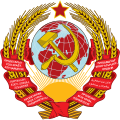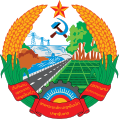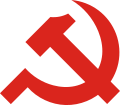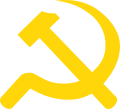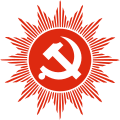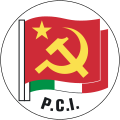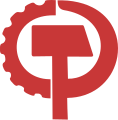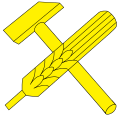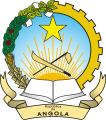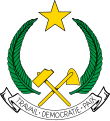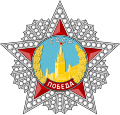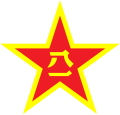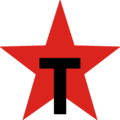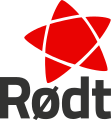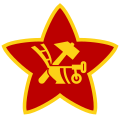|
Communist symbolism
Communist symbolism represents a variety of themes, including revolution, the proletariat, the peasantry, agriculture, or international solidarity. The red flag, the hammer and sickle and the red star or variations thereof are some of the symbols adopted by communist movements, governments, and parties worldwide. A tradition of including communist symbolism in socialist-style emblems and flags began with the flag of the Soviet Union and has since been taken up by a long line of socialist states. In Indonesia, Latvia, Lithuania and Ukraine, communist symbols are banned and displays in public for non-educational use are considered a criminal offense.[1] Hammer and sickle  The hammer and sickle appears on the flags of most communist parties around the world. Some parties have a modified version of the hammer and sickle as their symbol, most notably the Workers' Party of Korea which includes a hammer representing industrial workers, a hoe representing agricultural workers, and a brush (traditional writing-implement) representing the intelligentsia. The hammer stands for the industrial working class and the sickle represents the agricultural workers, therefore together they represent the unity of the two groups.[2] The hammer and sickle was first used during the 1917 Russian Revolution, but it did not appear on the official flag of the Union of Soviet Socialist Republics until 1924.[2] Since the Russian Revolution, the hammer and sickle has been used by various communist parties and communist states. Red star The red five-pointed star is a symbol of the ultimate triumph of the ideas of communism on the five (inhabited, excluding Antarctica) continents of the globe. It first appeared as a military symbol in Tsarist Russia. It was then called the “Mars star,” reminiscent of Mars, the ancient Roman god of war. On January 1, 1827, the law was signed that put a five-pointed star on the epaulets of officers and generals. In 1854, the star began to be used on shoulder straps. Later, the five-pointed star with a two-headed eagle inside it was used to mark military trains and carriages. In Soviet Russia, the five-pointed star symbolized the protection of peacetime labor by the Red Army (again, like in Ancient Rome, where Mars was also the protector of the agricultural workers). In 1918, the drawing of the badge for the soldiers of the Red Army in the form of a red star with a golden image of a plough and a hammer in the center was approved. The star symbolized protection, while the plough and the hammer were read as a union of workers and peasants. By the 1920s, the red star began to be used as an official symbol of the state, and finally, in 1924, it became part of the Soviet flag and the official emblem of the Soviet Union.[3][4] In the succeeding years, the five-pointed red star came to be considered a symbol of communism as well as of broader socialism in general. It was widely used by anti-fascist resisting parties and underground socialist organizations in Europe leading up to and during World War II. During the war, the red star was prominently used as a symbol of the Red Army troops of the Soviet Union countering the invading forces of Nazi Germany and wiping them out of Eastern Europe, achieving absolute victory, and ending the war at the Battle of Berlin.[citation needed] Most states in the Eastern Bloc incorporated the red star into state symbols to signify their socialist nature. Red flag The red flag is often seen in combination with other communist symbols and party names. The flag is used at various communist and socialist rallies like May Day. The flag, being a symbol of socialism itself, is also commonly associated with non-communist variants of socialism. The red flag has had multiple meanings in history. It is associated with courage, sacrifice, blood and war in general, but it was first used as a flag of defiance.[5] The red flag gained its modern association with communism in the 1871 French Revolution.[citation needed] After the October Revolution, the Soviet government adopted the red flag with a superimposed hammer and sickle as its national flag. Since the October Revolution, various socialist states and movements have used the red flag. Red and black flag The red and black flag has been a symbol of general communist movements, though generally used by anarcho-communists. The flag was used as the symbol of the anarcho-syndicalists during the Spanish Civil War. The black represents anarchism and the red represents leftist and socialist ideals.[6] Over time, the flag spilled into statist leftist movements, these movements include the Sandinistas and the 26th of July Movement, where the flags colors are not divided diagonally, but horizontally. As in the case of the Sandinistas, they adopted the flag due to the movement's anarchist roots.[7] The InternationaleThe Internationale is an anthem of the Communist movement.[8] It is one of the most universally recognized songs in the world and has been translated into nearly every spoken language. Its original French refrain is C'est la lutte finale/Groupons-nous et demain/L'Internationale/Sera le genre humain (English: This is the final struggle/Let's group together and tomorrow/The International/Will be the human race). It is often sung with a raised fist salute. The song has been used by communists all over the world since it was composed in the 19th century and adopted as the official anthem of the Second International. It later became the anthem of Soviet Russia in 1918 and of the Soviet Union in 1922. It was superseded as the Soviet Union anthem in 1944 with the adoption of the State Anthem of the Soviet Union, which placed more emphasis on patriotism. The song was also sung in defiance to Communist governments, such as in the German Democratic Republic in 1989 prior to reunification as well as in the People's Republic of China during the Tiananmen Square protests of the same year.[9][10] Plough or Starry Plough  The original Starry Plough was designed by William H. Megahy, though the concept may have originated with George William Russell, for the Irish Citizen Army[11] and showed silver stars on a green background.[12] The flag depicts an asterism (an identified part) of the constellation Ursa Major, called The Plough (or "Starry Plough") in Ireland and Britain, the Big Dipper in North America, and various other names worldwide. Two of the Plough's seven stars point to Polaris, the North Star. James Connolly, co-founder of the Irish Citizen Army with Jack White and James Larkin, said the significance of the banner was that a free Ireland would control its own destiny from the plough to the stars.[13] The sword as the plowshare is also a biblical reference in Isaiah 2:3-4. In the bible verse, God pushes his followers to turn their weapons into tools, turning the means for war into the means for peace. The marriage of Catholic tradition, the biblical reference being integral to the flag's design, with socialist concepts, like the working class and the oppressor forcing them to take up their plowshares as arms, leaves the Starry Plough flag with complexity and nuanced implications, which culminate in a very wide range of interpretations.[14] During the 1930s the design changed to a blue banner which was designed by members of the Republican Congress, and was adopted as the emblem of the Irish Labour movement, including the Labour Party. Labour adopted the rose as its official emblem in 1991 but continued to use the Starry Plough for ceremonial occasions, and in 2021 the party reverted to using the Starry Plough as their primary symbol (this time with white stars on a red background).   In China, the Plough flag (Chinese: 犁头旗), a red flag with white or yellow plough, was widely used in the period of the First Revolutionary Civil War as the flag of the Chinese Peasants' Association, an organization led by the Chinese Communist Party.[15][16] It is believed that Peng Pai (Chinese: 彭湃) was the first user in 1923 at the peasants' association of Hailufeng.[17] The Plough flag has many different versions and some are combined with the flag of Blue Sky, White Sun or Red Field;[18] other are different on the details of the plough.[19][20] National emblems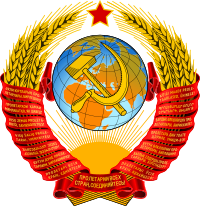 Many communist governments purposely diverged from the traditional forms of European heraldry in order to distance themselves from the monarchies that they usually replaced, with actual coats of arms being seen as symbols of the monarchs. Instead, they followed the pattern of the national emblems adopted in the late 1910s and early 1920s in Soviet Russia and the Soviet Union.[citation needed] Other communist symbolsWhile not necessarily communist in nature, the following graphic elements are often incorporated into the flags, seals and propaganda of communist countries and movements.
Notable examples of communist states that use no overtly communist imagery on their flags, emblems or other graphic representations are Cuba and the former Polish People's Republic. GalleryExamples of these symbols in use. Hammer and sickle
Red flag
Red star
Red and black flag
Plough
Other symbols
See also
References
Bibliography
External links |



























